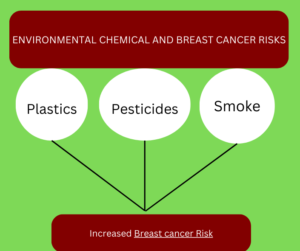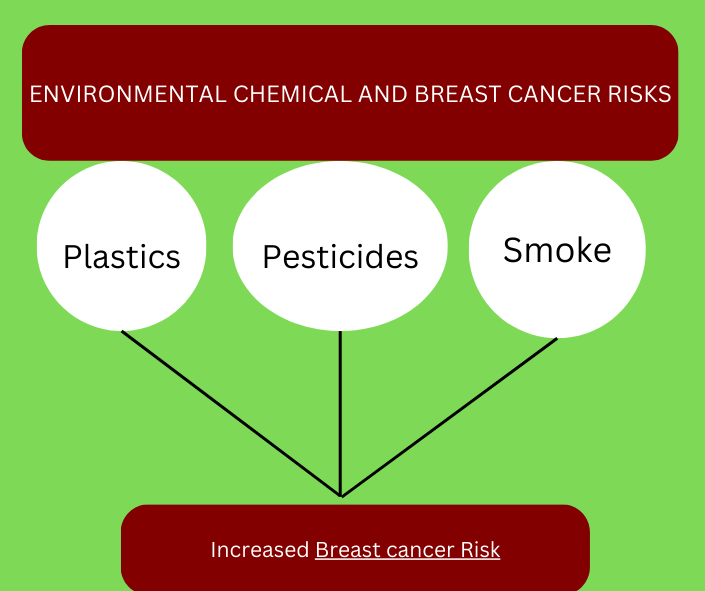At Dr Shilpy Dolas Breast clinic, we are dedicated to providing valuable information about breast health and empowering individuals to make informed choices. In this article, we delve into the topic of environmental chemicals and breast cancer risks with their potential impact on an individuals life. Our aim is to provide you with comprehensive insights and help you understand the relationship between environmental factors and breast cancer development.
The Complex Nature of Breast Cancer
Breast cancer is a multifaceted disease influenced by various factors, including genetic predisposition, lifestyle choices, and environmental exposures. While genetics play a crucial role, research suggests that environmental chemicals can also contribute to the development and progression of breast cancer.
Understanding Environmental Chemicals and Breast Cancer Risk
Environmental chemicals encompass a wide range of substances that exist in our surroundings, including industrial pollutants, pesticides, plasticizers, and personal care products. These chemicals can enter our bodies through ingestion, inhalation, or dermal absorption, and some may persist in our tissues for extended periods.

Chemicals of Concern
Several environmental and breast cancer risk association has seen in various studies. These chemicals have been identified as potential contributors to breast cancer risk. These include:
- Endocrine Disrupting Chemicals (EDCs): EDCs interfere with the body’s hormonal system and can mimic or block the actions of natural hormones. Common EDCs such as bisphenol A (BPA) and phthalates are found in plastics, food containers, and personal care products.
- Persistent Organic Pollutants (POPs): POPs are highly resistant to degradation and can accumulate in the environment and in living organisms. Examples of POPs include polychlorinated biphenyls (PCBs) and certain pesticides like DDT. These chemicals can enter the food chain and ultimately reach human populations.
- Aromatic Hydrocarbons: Aromatic hydrocarbons, such as polycyclic aromatic hydrocarbons (PAHs), are released during the combustion of fossil fuels, tobacco smoke, and charred or grilled foods. They have been linked to an increased risk of breast cancer.
Potential Mechanisms of Action
Their are precise mechanisms by which environmental chemicals and breast cancer risk development are still being explored. However, several potential pathways have been identified:
- Hormonal Imbalance: Some chemicals can disrupt the delicate balance of hormones in the body, leading to abnormal estrogen signaling, which is strongly associated with breast cancer development.
- DNA Damage: Certain chemicals have the ability to damage DNA, which can result in genetic mutations and alterations that promote cancerous cell growth.
- Inflammation and Oxidative Stress: Environmental chemicals may trigger chronic inflammation and oxidative stress, processes known to contribute to cancer initiation and progression.
Minimizing Exposure and Promoting Breast Health
While complete avoidance of environmental chemicals may be challenging, there are steps you can take to minimize exposure and promote breast health:
- Choose Safe Products: Opt for personal care products and household cleaners that are free from potentially harmful chemicals. Look for labels indicating “paraben-free,” “phthalate-free,” and “fragrance-free.”
- Avoid Plastic Containers: Whenever possible, choose glass or stainless steel containers for storing food and beverages, as certain plastics may leach harmful chemicals into your food.
- Go Organic: Select organic produce and prioritize foods that have been grown without the use of synthetic pesticides or fertilizers. This can help reduce exposure to harmful chemicals present in conventionally grown crops.
- Promote a Healthy Lifestyle: Maintain a well-balanced diet, engage in regular physical activity, limit alcohol consumption, and avoid smoking. These lifestyle choices can help reduce the overall risk of breast cancer.
Conclusion
In conclusion, while the relationship between environmental chemicals and breast cancer risk is complex, evidence suggests that
these chemicals can indeed play a role in the development and progression of breast cancer. Understanding the potential risks associated with environmental chemicals is crucial for making informed decisions about lifestyle choices and minimizing exposure.
At Dr Shilpy Dolas breast specialist in Pune Breast clinic, we are committed to providing you with the knowledge and tools to promote breast health and reduce the potential impact of environmental chemicals. By following the suggested measures outlined above, you can take proactive steps to minimize your exposure to harmful substances and create a healthier environment for yourself and your loved ones.
Remember, breast cancer is a complex disease influenced by various factors, and no single approach can completely eliminate the risk. However, by staying informed and adopting healthy lifestyle choices, you can significantly contribute to maintaining breast health.
The diagram above illustrates a comprehensive approach to breast health, encompassing lifestyle choices, minimizing exposure to environmental chemicals, and regular check-ups. By incorporating these practices into your daily life, you can actively take charge of your well-being and potentially reduce the risk of breast cancer.
If you have any query about breast cancer, contact Dr. Shilpy Dolas. She is an eminent breast cancer treatment specialist in Pune and deals with all kinds of breast-related issues with advanced ways of treating.
At Heart and Breast Care clinic by Dr. Shilpy Dolas, we remain dedicated to providing reliable information and resources to empower individuals like you in making informed decisions about their health. Together, we can create a future where breast cancer incidence is minimized, and individuals can lead healthy, fulfilling lives.
Remember, knowledge is power, and by staying informed about environmental chemicals and breast cancer risks association and their potential impact on breast cancer risk, you are taking a significant step towards safeguarding your health and well-being.
References:
- Smith, M.T. et al. (2013). Breast Cancer and the Environment: Why Public Health Messages Interfere with Individual Choice. Environmental Health Perspectives, 121(3), 196-204.
- Terry, M.B. et al. (2019). Environmental Exposures during Windows of Susceptibility for Breast Cancer: A Framework for Prevention Research. Breast Cancer Research, 21(1), 96.
Note: This article is for informational purposes only and should not be considered as medical advice. Consult with a healthcare professional Dr Shilpy Dolas for personalized guidance related to breast health and cancer prevention.
contact for appointments: +91-8237337784
locate us at:
- Dr. Shilpy Dolas private clinic-Heart and breast care clinic, pimpri – Monday to saturday
- Dr Shilpy Dolas at Jupiter Hospital – Monday and wednesday
- Dr Shilpy Dolas Ruby Hall Clinic, Breast Cancer Surgeon Wednesday and friday

